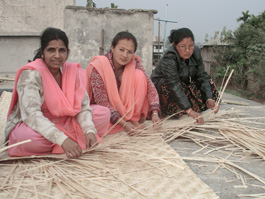Housing’s multiplier effect on the economy -- Habitat for Humanity Int'l 1
Housing’s multiplier effect on the economy
By Hiew Peng Wong
| |

In Habitat for Humanity Nepal’s bamboo enterprise, approximately 3,500 women are involved in weaving bamboo wall panels.
|
| |
|
Government investment in low-cost housing has a powerful “multiplier effect,” including the creation of many jobs, says Filipino economist Cielito F. Habito.
According to Habito, “Housing can be one of the most effective ways of stimulating consumption and production activity in other sectors of the economy.”1
“The key to the impact of government spending is the way a one-off expenditure by the government raises total production and incomes by several times the amount of the original expenditure, or the so-called multiplier effect,” he wrote in a Philippine newspaper column.2
“If the government spends 100 million pesos to build a new road, that amount turns into 100 million pesos in total incomes received by contractors, engineers, equipment suppliers, construction workers and others. But that’s not the end of it. Those various people now have money to spend or save as they choose.”
Habito, a professor at Ateneo de Manila University in the Philippines, also presented a paper titled “Housing as Economic Stimulus: How and Why?” at Habitat for Humanity’s second Asia/Pacific Housing Forum, held in Manila in 2009.
The multiplier effect can also be seen on a micro level in Habitat for Humanity’s programs in the Asia/Pacific region. Local skilled labor will always be in demand, but special builds and disaster response projects create greater employment opportunities. For example, local masons and carpenters were employed for Habitat Nepal’s 40-house Everest Build completed in October 2010.
----
THE MULTIPLIER EFFECT CAN ALSO BE SEEN ON A MICRO LEVEL IN HABITAT FOR HUMANITY’S PROGRAMS IN THE ASIA/PACIFIC REGION. LOCAL SKILLED LABOR WILL ALWAYS BE IN DEMAND, BUT SPECIAL BUILDS AND DISASTER RESPONSE PROJECTS CREATE GREATER EMPLOYMENT OPPORTUNITIES.
----
For the Everest Build, about 30 people from local communities were trained in building prefabricated bamboo housing.
In tsunami-devastated Sri Lanka, between 2005 and 2009, Habitat trained nearly 200 homeowners in block making, carpentry, electrical wiring, painting and masonry. After work was completed on the tsunami response projects, the homeowners found employment in construction projects in eastern Sri Lanka and the Middle East.
Through Habitat Sri Lanka’s Save & Build program in Central Province, Habitat homeowners have created home-based businesses after being registered with the provincial councils. Many families package the spices for which the Matale district is famous and sell them in the local markets. Their business acumen impressed the local government, which gave loans amounting to 1 million rupees (US$9,000) to the Save & Build groups. In turn, the Save & Build groups lend small amounts of about 25,000 rupees to other low-income families who wish to set up businesses.
One Sri Lankan family who once lived in a small hut before moving into a Habitat house is now cultivating four hectares (10 acres) of land and rearing cattle with help from the local government. A female head of household who started selling finger food from her Habitat house is now supplying delicacies to shops and hotels in Matale.
In Cambodia, livelihood training is incorporated into all of Habitat’s housing and community development projects. In the capital, Phnom Penh, community members are trained in business management and provided with small loans for business startups. In Siem Reap, families are trained in agriculture and animal husbandry and provided with seeds and chicks, ducks or pigs.
In Oudong, about 40 kilometers (25 miles) northwest of Phnom Penh, community members have been trained to produce handmade stabilized soil blocks, make liquid soap to sell in local markets, create handicrafts for sale to tourists, and raise chicks or ducks. In January 2011, Habitat Cambodia began partnering with International Children’s Care Australia to provide families in Oudong with agricultural training and work on a cooperative farm.
Habitat Cambodia’s newest project in Phnom Penh and Prey Veng, in the southeast, will offer livelihood training to people living with HIV/AIDS and caretaker families of orphaned and vulnerable children, in addition to providing microloans for business startups.
Habitat’s enterprises also boost the local economy. With the November 2010 launch of Habitat Nepal’s bamboo enterprise in Jhapa in the east, more jobs are created for people who work in the enterprise along with those who cultivate the bamboo.
The factory will initially produce 180 corrugated bamboo roofing sheets and wall panels each day, eventually increasing to 280 sheets. About 3,500 women in Jhapa will help weave the wall panels, which will then be sent to the factory for laminating. Each woman will be paid 150 rupees (US$2) for weaving 1½ mats.
Initially, raw materials will come from within Nepal, as it takes three to four years before bamboo can be harvested. Habitat Nepal has already engaged women groups and other organized groups in cultivating bamboo on 100 hectares (248 acres) of land and nurseries in and around Jhapa.
Just as Habito states that government investment in low-cost housing can create a multiplier effect for local economies, Habitat’s investment leads to greater employment in communities where Habitat works.
Hiew Peng Wong is an editor/writer at Habitat for Humanity’s Asia/Pacific area office.
1 Habito, Cielito. “Housing as economic stimulus.” Philippine Daily Inquirer, Sept. 6, 2009.
2 Habito, Cielito. “Spending our way out of crisis.” Philippine Daily Inquirer, Dec 14, 2008.